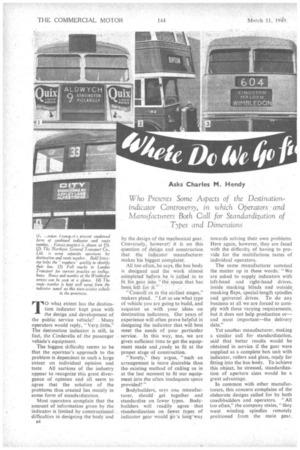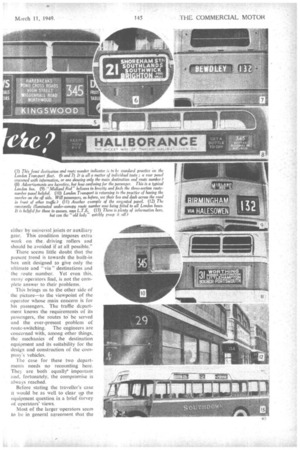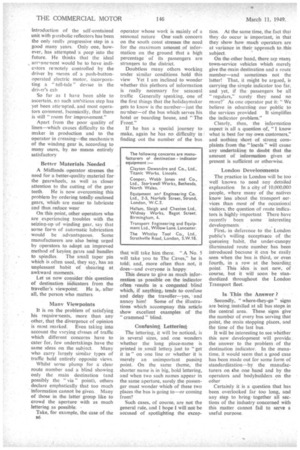Asks Charles M. Hendy W ho Presents Some Aspects of the
Page 12

Page 13

Page 14

If you've noticed an error in this article please click here to report it so we can fix it.
Destinationindicator Controversy , in which Operators and Manufacturers Both Call for Standardization of Types and Dimensions TO what extent has the destination indicator kept pace with the design and development of the public . servicevehicle? Many. operators would reply, ". Very, little." The destination indicator is still, in fact, the Cinderella of the passenger vehicle's equipment.
The. biggest difficulty seems to be that the operator's approach to the problem is dependent to such a large extent on individual opinion and
taste All sections of the industry appear to recognize this. great divergence of opinion and all, seem to agree that the solution of the problems thus created lies mainly in some form of standardization.
Most operators complain that the amount of, inforination given by the ' indicator-is limited by .construetional difficulties in designing the. 'body 'and
by the design of the mechanical gear. COnversely,' however; it is on this question of design and construction that the indicator manufacturer makes his biggest complaint.
All too often, he says, the bus body is designed and the work almost completed 'before he is :called in to fit his gear into the spaee,that has b.eeit left for it
"Consult ui in the earliest stages," makers plead. " Vet us' see what type of vehicle you are going to build, and acquaint us with your, ideas on destination indicators. Our years of experience will often prove helpful in designing the indicator that wilt-best meet the needs of your particular service.. In this way, too, we are given sufficient time to get the equipment made and ,ready to fit at the proper stage of construction.
"Surely," they argue, "such an arrangement is more desirable than the existing method of calling us in at the last moment to fit our equipment into the often inadequate space provided?"
Bodybuilders, says one manufacturer, should get together and standardize on fewer types. Bodybuilders will readily agree that standardization on fewer types of indicator -gear would go .a long way
towards solving their own problems. Here again, however, they are faced with the difficulty of having to provide for the multifarious tastes of individual operators.
The same manufacturer summed the matter up in these words: "We are asked to supply indicators with left-hand and right-hand drives, inside masking blinds and outside. masking flaps, special-length spindles and universa1 drives. To do any business at all we are forced to comply with these varying requirements, but it does not. help production or— and most important—the delivery date."
Yet anothei manufacturer, making a similar call for standardization, said that better results would be obtained in service_ if the gear were supplied as a complete box unit with indicator, rollers and glassy ready for fitting into the bus body. To achieve this object, he stressed, standardization of aperture sizes. would be a great advantage.
In common with . other manufacturers, this concern complains of the elaborate designs called for by both coaehbuilders and operators. "All too often," the company states, "they want winding spindles remotely positioned from the main gear, either by Universal joints or auxiliary gear. This condition imposes extra work on the, driving rollers and should be avoided if at all possible."
There seems little doubt that the present trend is towards the built-in box unit designed to give only the ultimate and "via destinations and the route number. Yet even this, many operators find, is not the complete answer to their problems.
This brings us to the other Side of the picture—to the viewpoint of the operator whose main concern is for his passengers. The traffic department knows the requirements of its passengers, the routes to be served and the ever-present problem of route-switching. The engineers are concerned With, among other things, the mechanics of the destination equipment and its suitability for the design and construction of the company's vehicles.
The case for these two departments needs no recounting here. They are both equally' important and, fortunately, the compromise is always reached.
Before stating the traveller's case it would be as well to clear up the equipment question in a brief survey of operators' views.
Most of the larger operatorsseem to be in general agreement that the
introduction of the self-contained unit with parabolic reflectors has been the only really progressive step in a good many years. Only one, however, has attempted a peep into the future. He thinks that the ideal arr-ngement would be to have indicators remotely controlled by the driver by means of a push-buttonoperated electric motor, incorporating a " tell-tale" device in the dri'e's cab So far as I have been able to ascertain, no such amhitious step has yet been attempted, and most operators comment. laconically, that there is still " room for improvement."
Apart from the poor quality of linen—which causes difficulty to the maker in production and to the operator in creasing—the mechanism of the winding gear is, according to many users, by no means entirely satisfactory Better Materials Needed A Midlands operator stresses the need for a better-quality material for the gearwheels. as well as closer attention to the cutting of the gear teeth. He is now overcoming this problern by ordering totarly enclosed gears, which are easier to lubricate and thus reduce wear
On this point, other operators who are experiencing troubles with the seizing-up of winding gear, say that some form of automatic lubrication would be advantageous. Some manufacturers are also being urged by operators to adopt an improved method of keying gears and handles
to spindles. The small taper pin which is often used, they say, has an unpleasant habit of shearing at awkward moments.
Let us now consider this question of destination indicators from the traveller's viewpoint. He is,. after all, the person who matters Many Viewpoints It is on the problem of satisfying his requirements, more than any other, that the divergence of opinion is most . marked. Even taking into account the varying classes of traffic which different concerns have to cater for, few undertakings have the same ideas on the subject. Many who carry largely similar types of traffic bold entirely opposite views.
Whilst some plump for a clear route number and a blind showing only the main destination (and possibly the " via " point), others declare emphatically that too much information cannot be given. Many of those in the latter group like to crowd the aperture with as much lettering as possible.
Take, for example, the case of the B6 operator whose work is mainly of a seasonal nature One such concern on the south coast stresses the need for the maximum amount of information on the ground that a high percentage• of its passengers are strangers to the district.
Doubtless many others working under similar conditions hold this view Yet I am inclined to wonder whether this plethora of information is really necessary for seasonal traffic Generally speaking, one of the first things that the holidaymaker gets to know is the number—just the number—of the bus which serves his hotel or boarding house, and "The Front."
If he has a special journey to make, again he has no difficulty in finding out the number of the bus
that will take. him there. "A No. 5 will take you to The Caves," he is told; and, more often than not, it does—and everyone is happy.
This desire to give as much information as possible on the indicator often results in a congested blind which, if anything,. tends to confuse and delay the traveller—yes, ,and annoy him! Some of the illustrations which accompany this article show excellent examples of the " crammed " blind.
Confusing Lettering
The lettering, it will be noticed, is in several sizes, and one wonders whether the long place-name is printed in ,small letters just to " get it in " on one line or whether it is merely an unimportant passing point. On the same theme, the shorter name is in big, bold lettering, and when two such names appear in the same aperture, surely the passenger must wonder which of these two places the bus is going to—or coming from?
Such cases, of course, are not the general rule, and I hope I will not be accused of spotlighting the excep
tion. At the same time, the fact that they do occur is important, in that they show how much operators are at variance in their approach to.this subject.
On the other hand, there are many town-service vehicles which merely give the main destination and a route number—and sometimes not the latter! That, it might be argued, is carrying the simple indicator too far. and yet, if the passengers be all "regulars," surely they need no more? As one operator put it; "We believe in educating our public to the services provided It simplifies the indicator problem."
Clearly, then, the information aspect is all a question of, "I know what is best for my own customers," and nothing short of strong complaints from the " locals " will cause any undertaking to doubt that the amount of information given at present is sufficient or otherwise.
London DeyeloPments
The practice in London will be too well known to need any detailed explanation In a city, of 10,000,000 people, where many of the natives know less about the transport -services than most of the occasional visitors, the question of route indicators is highly important There have recently been some interesting developments. .
First, in deference to the London public's willing acceptance of the queueing habit, the under-canopy illuminated route number. has been introduced because it can be easily seen when the bus is third, or even fourth, in a row at the boarding point. This idea is not new, of course, but it will soon be standardized throughout the London Transport fleet.
Is This the Answer ?
Secondly, " where-they-go " signs are being installed at all bus stops in the central area. These signs give the number of every bus serving that point, the main stopping places, and the time of the last bus.
It will be interesting to see whether this new development will provide, the answer to the problem of the destination indicator. In the meantime, it would seem that a good case has been made out for some form of standardization—by the manufacturers on the one hand and by the operators and bodybuilders on the other Certainly it is a question that has been overlooked far too long, and any step to bring together all sections of the industry concerned with this matter cannot fail to serve a useful purpose.


























